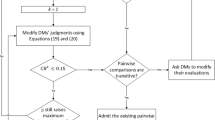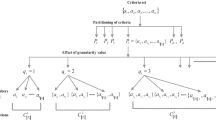Abstract
The aim of this paper is to identify and discuss some of the important and critical decision criteria including cleaner production implementation of an efficient system to prioritize competitive priorities. Fuzzy analytic network process (FANP) based methodology is discussed to tackle the different decision criteria involved in the selection of competitive priorities in current business scenario. FANP is an efficient tool to handle the fuzziness of the data involved in deciding the preferences of different decision variables. The linguistic level of comparisons produced by the professionals and experts for each comparison are tapped in the form of triangular fuzzy numbers to construct fuzzy pairwise comparison matrices. The implementation of the system is demonstrated by a problem having four stages of hierarchy which contains different criteria, attributes and alternatives at wider perspective. The proposed model can provide a hierarchical framework for the cleaner production implemented organization to select on its competitive priorities.


Similar content being viewed by others
References
Adamson C (1995) How to waste money measuring customer satisfaction. Manag Serv Qual 4(5):9–12
Ahire SL, Golhar DY, Waller MA (1996) Development and validation of TQM implementation constructs. Decis Sci 27(1):23–56
Allenby B (2004) Clean production in context: an information infrastructure perspective. J Clean Prod 12:833–839
Avella L, Fernandez E, Vazquez CJ (2001) Analysis of manufacturing strategy as an explanatory factor of competitiveness in the large Spanish industrial firm. Int J Prod Econ 72:139–157
Bayazit O, Karpak B (2007) An analytical network process based framework for successful total quality management: an assessment of Turkish manufacturing industry readiness. Int J Prod Econ 105:79–96
Bessant J, Caffyn S, Gallagher M (2001) An evolutionary model of continuous improvement behavior. Technovation 21:67–77
Buckley JJ (1985) Fuzzy hierarchical analysis. Fuzzy Sets Syst 17:233–247
Bunney HS, Dale BG (1997) The implementation of quality management tools and techniques: a study. TQM Mag 9(3):183–189
Camisón C (1998) Total quality management and cultural change: a model of organizational development. Int J Technol Manag 16(4/5/6):479–493
Chase RB, Aquilano NJ, Jacobs ER (2001) Operations management for competitive advantage (9th edn), McGraw-Hill, Irwin, p 30
Chenhall RH, Langfield-Smith K (1998) The relationship between strategic priorities, management techniques and management accounting: an empirical investigation using a system approach. Account Organ Soc 23(3):243–264
Chiang JH, Tseng ML, Chiu ASF, Divinagracia L (2006). Integrating environmental uncertainty and risks, competitive priorities and cleaner production implementation toward principles of sustainable production. DLSU J Bus Manag 2(1)
Dale BG, Boaden RJ (1993) Improvement framework. TQM Mag 5(1):23–26
Dale BG, Lascelles DM (1990) The use of quality management techniques. Qual Forum J 16:14
De Bruijn TJNM, Hofman PS (2000) Pollution prevention and industrial transformation evoking structural changes within companies. J Clean Prod 8:215–223
Deming E (1986) Out of the crisis. MIT, Cambridge
Dunn RF, Bush GE (2001) Using process integration for cleaner production. J Clean Prod 9:1–13
Dreyer B, Gronhaug K (2004) Uncertainty, flexibility, and sustained competitive advantage. J Bus Res 57:484–494
Dyer RF, Forman EH (1992) Group decision support with the analytic hierarchy process. Decis Support Syst 8(2):99–124
Evans JR, Lindsay WM (1995) The management and control of quality, 3rd edn. West Publishing, New York
Fresner J (1998) Starting continuous improvement with a cleaner production assessment in an Austrian textile mill. J Clean Prod 6:85–91
Frohlich MT, Dixon JR (2001) A taxonomy of manufacturing strategies revisited. J Oper Manag 19:541–558
Fuentes-Fuentes MM, Albacete-Saez CA, Lloren-Montes FJ (2004) The impact of environmental characteristics on TQM principles and organizational performance. Int J Manag Sci 32:425–442
Grutter JM et al (2004) From cleaner production to sustainable industrial production modes. J Clean Prod 12:249–256
Hayes RH, Wheelwright SC (1984) Restoring out competitive edge: competing through manufacturing. Wiley, New York
Henderson S (1997) Black swans don’t fly double loops: the limits of the learning organization? Learn Organ 5:99–105
Hill RA (1996) Measure of the learning organization. Ind Commer Train 28:19–25
Hill T (2000) Manufacturing strategy. Richard Irwin, Homewood
Ho KM (1995) Is the ISO 9000 series for total quality management? Int J Phys Distrib Logist Manag 25(1):51–66
James PTJ (1996) Total quality management: an introductory text. Prentice-Hall, Englewood Cliffs
Jung JY, Wang YJ (2006) Relationship between total quality management and continuous improvement of international project management. Technovation 26:716–722
Juran J (1989) Juran on planning for quality. ASQC, Milwaukee
Kathuria R (2000) Competitive priorities and managerial performance: taxonomy of small manufacturers. J Oper Manag 18:627–641
Kirkwood A (2003) Going outside the box: skills development, cultural change and the use of on-line resources. Comput Educ 47(3):316–331
Kwong CK, Bai H (2002) A fuzzy AHP approach to the determination of importance weights of customer requirements in quality function development. J Intell Manuf 13:367–377
Logothetis N (1992) Managing for total quality: from Deming to Taguchi and SPC. Prentice-Hall, London
Madu CN, Kuei CH, Winokur D (1995) Environmental quality planning. Future 27(8):839–856
Meade LM, Sarkis J (1998) Strategic analysis of logistics and supply chain management systems using analytical network process. Logist Transp Rev 34(3):201–215
Meade LM, Liles DH, Sarkis J (1997) Justifying strategic alliances and partnering: a prerequisite for virtual enterprising. Omega 25(1):29–42
Miettinen P, Hamalainen RP (1997) How to benefit from decision analysis in environmental life cycle assessment. Eur J Oper Res 102:279–294
Moors EHM, Nulder KF, Vergrat PJ (2005) Towards cleaner production: barriers and strategies in the base metals producing industry. J Clean Prod 13:657–668
Opricovic S, Tzeng GH (2004) Compromise solution by MCDM methods: a comparative analysis of VIKOR and TOPSIS. Eur J Oper Res 156(2):445–455
Palermo RC, Watson GH (1993) A world of quality: business transformation at Xerox. Xerox Quality Services, Rochester
Rao S, Subba T, Ragu-Nathan S, Solis LE (1997) Does ISO 9000 have an effect on the quality management practices? An international empirical study. Total Qual Manag 8(6):335–346
Saaty TL (1980) The analytic hierarchy process. McGraw-Hill, New York
Saaty TL (1996) Decision making with dependence and feedback: the analytic network process. RWS, Pittsburgh
Sarkis J (1998) Evaluating environmentally conscious business practices. Eur J Oper Res 107:159–174
Sethi AK, Sethi SP (1990) Flexibility in manufacturing: a survey. Int J Flex Manuf Syst 2:289–328
Shriberg M (2002) Toward sustainable management: the university of Michigan housing division’s approach. J Clean Prod 10:41–45
Sinclair D, Zairi M (1995) Performance measurement as an obstacle to TQM. TQM Mag 7(3):42–45
Skinner W (1969) Manufacturing-missing link in corporate strategy. Harvard Bus Rev 3:136–144
Smith PG, Reinertsen DG (1991) Developing products in half the time. Van Nostrand Reinhold, New York
Stone LJ (2006a) Limitations of cleaner production programs as organizational change agents. I. Achieving commitment and on going improvement. J Clean Prod 14:1–14
Stone LJ (2006b) Limitations of cleaner production programs organizational change agents. II. Leadership, support, communication, involvement and program design. J Clean Prod 14:15–30
Tan PKL (1997) An evaluation of TQM and the techniques for successful implementation. Train Qual 5(4):150–159
Tseng ML, Chiu ASF, Lin YY, Chiang JH (2006) The relationship of continuous improvement and cleaner production on operational performance: an empirical study in electronic manufacturing firms, Taiwan. Int J Manag Sci Eng Manag 1(1):71–80
Tseng ML, Lin YH, Chiu ASF, Liao CH (2007) A structural equation model of total quality management and cleaner production implementation. J Am Acad Bus, Cambridge 10(2) (in press)
Ugboro IO, Obeng K (2000) Top management leadership, employee empowerment, job satisfaction and customer satisfaction in TQM organizations: an empirical study. J Qual Manag 4:247–272
Van Dierdonck R, Miller JG (1980) Designing production planning and control systems. J Oper Manag 1(1):37–46
Wheelwright SC, Bowen HK (1996) The challenge of competitive advantage. Prod Oper Manag 5(1):59–77
White RE, Pearson JN, Wilson JR (1999) JIT manufacturing: a survey of implementations in small and large US manufacturers. Manag Sci 45(1):1–15
Wu CW, Chen CL (2006) An integrated structural model toward successful continuous improvement activity. Technovation 26:697–707
Wu WW, Lee YT (2007) Selection knowledge management strategies by using the analytical network process. Expert Syst Appl 32:841–847
Zhang Q, Vonderembse MA, Lim JS (2002) Manufacturing flexibility: Defining and analyzing relationships among competence, capability and customer satisfaction. J Oper Manag 327:1–19
Zhou Z (2001) Process control and cleaner production. International conference on cleaner production, Beijing, paper 24 of 30
Zilahy G (2004) Organizational factors determining the implementation of cleaner production measures in the corporate sector. J Clean Prod 12(4):311–319
Author information
Authors and Affiliations
Corresponding author
Rights and permissions
About this article
Cite this article
Tseng, M.L., Lin, Y.H., Chiu, A.S.F. et al. Using FANP approach on selection of competitive priorities based on cleaner production implementation: a case study in PCB manufacturer, Taiwan. Clean Techn Environ Policy 10, 17–29 (2008). https://doi.org/10.1007/s10098-007-0109-4
Received:
Accepted:
Published:
Issue Date:
DOI: https://doi.org/10.1007/s10098-007-0109-4




